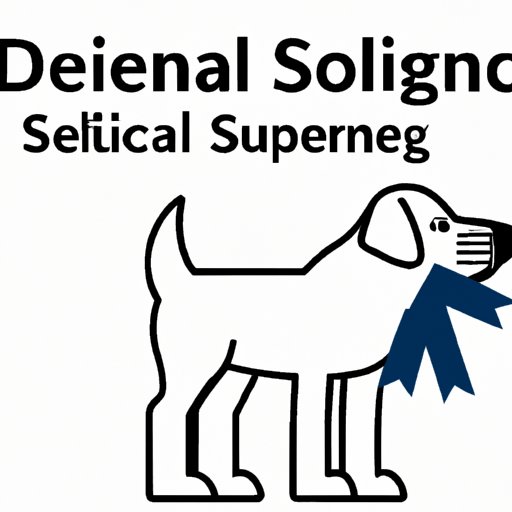Introduction
A service dog is a highly trained animal that assists individuals with disabilities in completing tasks or mitigating challenges in their daily lives. If you or a loved one experiences a disability or other limiting condition, a service dog may be a valuable asset, offering independence, comfort, and safety. However, the process of getting a service dog can be complex and may involve a substantial financial and time commitment. This guide provides an overview of the steps involved in getting a service dog, as well as tips for choosing, training, and owning a service animal.
10 Steps to Qualifying for a Service Dog
Definition and Legal Aspects of Service Animals
Before applying for a service dog, it’s important to understand exactly what a service animal is and what legal protections they are entitled to. Service animals are specifically trained to complete tasks or assist with tasks related to a person’s disability, such as opening doors, navigating crowds, or alerting individuals to a medical emergency. Under the Americans with Disabilities Act (ADA), service animals are allowed to accompany individuals with disabilities in all public areas, including restaurants, stores, and public transportation. If you have a disability and your service animal is denied access to a public area, you have the legal right to file a complaint.
Eligibility Requirements
To qualify for a service animal, individuals must have a disability that substantially impairs one or more major life activities. This can include physical disabilities, such as blindness or hearing loss, as well as mental health conditions such as anxiety, depression, or post-traumatic stress disorder (PTSD). Additionally, individuals must be able to communicate commands to the service animal or have someone with them who can provide that communication.
The Application Process and Time frames
The process of getting a service dog can vary depending on the organization or trainer you work with. Some organizations have waiting lists that can be several years long, while others may have quicker turnaround times. Generally, the process involves an application, an interview, and a training period. Some organizations may also require proof of disability or a medical statement.

How to Choose the Right Service Dog
Different Types of Service Dogs and Their Functions
There are many different types of service dogs, each with specific functions that can help individuals with disabilities. Some common types include guide dogs, hearing dogs, mobility dogs, medical alert dogs, and psychiatric service dogs. Guide dogs help individuals with visual impairments navigate their surroundings. Hearing dogs assist individuals who are deaf or hard of hearing by alerting them to sounds such as doorbells, timers, or alarms. Mobility dogs can assist individuals with mobility impairments in tasks such as opening doors, retrieving objects, or pulling wheelchairs. Medical alert dogs can detect changes in blood sugar, alert individuals to seizures, or recognize other medical issues. Psychiatric service dogs may help individuals with conditions such as PTSD or anxiety by providing comforting presence or improving communication with others.
Traits that Make a Good Service Dog
When choosing a service dog, it’s important to look for specific traits that will help the animal excel in its tasks. Service dogs should be calm, focused, and responsive to training. Additionally, they should be well-behaved in public places, able to remain calm in crowds, and not easily distracted by other people or animals. Physical attributes such as size and strength may also be a factor depending on the individual’s needs and lifestyle.
Breeds that Commonly make Good Service Dogs
While many breeds can make good service dogs, some are particularly well-suited for specific tasks. Labrador retrievers are often used as guide and mobility dogs, as they are intelligent, loyal, and responsive to training. German shepherds can be excellent all-purpose service dogs, with strong instincts for protection and loyalty. Poodles and other non-shedding breeds are often chosen as hypoallergenic service dogs. Terriers and other small breeds may be appropriate for alert tasks.
The Cost of Owning a Service Dog
Initial and Ongoing Expenses
Owning a service dog can be a costly endeavor. Initial expenses can include the cost of purchasing or adopting a dog, any necessary medical exams, and training fees. After the initial expenses, ongoing costs can include food, grooming, routine medical care, and supplies such as toys, leashes, and vests. Additionally, other unexpected expenses such as emergency veterinary care or training updates may arise.
Financing Options
Due to the high cost of owning a service dog, there are several financing options available to help offset the expenses. These include grants from non-profit organizations, loans and credit options, and crowdfunding options. Some organizations that train and provide service dogs also offer financing or payment plans.
Insurance Options
Owning a service dog can also impact your insurance. Some health insurance policies may cover the cost of obtaining a service dog or therapy dog if it is deemed medically necessary. Additionally, some pet insurance policies offer coverage for service dogs. However, it’s important to check with your insurance provider to find out what coverage is available and what the requirements are.
Finding a Service Dog Trainer Near You
Certification and Training Programs
Not all service dog trainers are created equal, so it’s important to do your research to find a reputable trainer who has experience training service dogs. Look for trainers who have completed certification programs and have experience working with individuals with disabilities. Additionally, training programs should use positive reinforcement techniques and have a commitment to ongoing education.
Researching Reputable Trainers
The best way to find a reputable trainer is through personal referrals. Talk to other individuals with service dogs or disability organizations to get recommendations. Additionally, look for trainers who have online reviews and ratings from past clients and professional organizations.
Consumer Reviews and Ratings
Online reviews can provide valuable information about the quality of service provided by different trainers. Look for trainers with consistently positive ratings and testimonials from individuals who have worked with them. Additionally, check with professional organizations such as Assistance Dogs International or the International Association of Assistance Dog Partners to find accredited trainers near you.
Training Your Own Service Dog
The Benefits of Training Your Own Service Dog
Training your own service dog can be a valuable and rewarding experience. It can help to build a strong bond between you and your animal, and provide a sense of accomplishment in mastering new skills. Additionally, training your own service dog can be less expensive than working with a professional trainer. However, it’s important to note that training your own service dog requires a significant time commitment and requires a thorough understanding of training techniques.
The Steps and Strategies for Training Your Own Service Dog
Training your own service dog can be broken down into several steps, including selecting a dog, basic obedience training, task training, and public access training. Depending on the task that the service dog will perform, additional training may be necessary. When training your own service dog, it’s important to adhere to positive reinforcement techniques, as punishment or negative reinforcement can be harmful to the dog and impair its functioning.
Training Techniques for Service Animal Tasks
The types of training necessary for service dog functions vary widely depending on the individual and the dog. Basic obedience training, such as leash walking, sitting, and staying, is a foundation for all service dogs. Task training can involve teaching dogs to retrieve objects, provide support, or perform a specific action when prompted. Public access training involves training the dog to remain calm and focused in crowded areas, such as stores or restaurants. Under the ADA, service dogs must be allowed in all public areas, so it’s important for them to be well-behaved in those areas.
The Benefits of Owning a Service Dog
The Emotional Benefits
Service dogs can offer emotional benefits to individuals with disabilities, such as reducing anxiety and depression. Through companionship and the ability to complete tasks, service dogs can offer a sense of independence and level of connection that is difficult to achieve through other means.
The Physical Benefits
Service dogs can also provide physical benefits to individuals with disabilities, such as helping with mobility, balance, and safety. By completing tasks such as retrieving objects or opening doors, service dogs can help individuals to achieve greater independence and enhance their physical abilities.
The Practical Benefits
Service dogs can also provide practical benefits to individuals with disabilities, by alerting them to impending medical emergencies or providing protection in public areas. Additionally, service dogs can enhance individuals’ quality of life by allowing them to achieve greater levels of independence and participation in activities they enjoy.
Service Dog Etiquette: What You Need to Know
Proper Etiquette for Interacting with Service Animals
Interacting with service animals can be tricky – while service dogs are highly trained animals, they are still animals and can become distracted by misbehavior or well-meaning strangers. To interact with a service dog properly, it’s important to always ask the handler’s permission before petting or interacting with the animal. Additionally, it’s important to treat the service dog as a working animal, rather than as a pet or distraction.
Legal Implications of Different Situations
Service animals are entitled to legal protections under the ADA. This means that individuals with disabilities have the right to bring their service animal with them to all public areas, and cannot be denied access based solely on the presence of their animal. However, it’s important to note that not all animals are service animals – emotional support animals, therapy animals, and pets do not enjoy the same legal protections as service animals.
Public Awareness
Increasing public awareness of service animals and their role in helping individuals with disabilities is an important component of responsible service dog ownership. Encouraging individuals to ask questions and learn more about the legal and practical implications of service animal ownership can help to reduce misunderstandings and promote greater acceptance of individuals with disabilities and their animals.
Conclusion
Summary of Major Points
Getting a service dog can be a valuable asset for individuals with disabilities, providing independence, comfort, and safety. Qualifying for a service dog involves understanding legal aspects and eligibility requirements, choosing and training the right animal, and navigating the financial and emotional costs. It is important to have a profound understanding of what is required and what steps are included in the process of getting a service dog.
Final Thoughts and Recommendations
If you or a loved one is interested in getting a service dog, it’s important to do your research and understand the commitment involved. Working with a professional trainer or training your own service dog can be challenging, but ultimately rewarding. By following the steps outlined in this guide and being mindful of service dog etiquette, you can create a successful and fulfilling partnership with your service animal.
